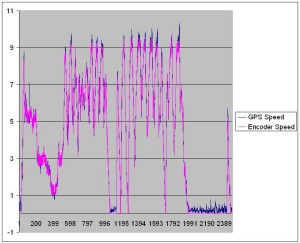I have a Pololu 9 DOF IMU (version 2) that uses an LSM303DLLC for the magnetometer and accelerometer. With these two sensors you can create a tilt compensated compass. It was my plan to do exactly that to get heading for my robot as I do not fully trust the GPS heading especially moving at slow speeds. But discussion on the DiyRovers forum may make me change my mind.
In any case, it did not take much effort to rehost the sample code from Pololu for my ARM processor. The biggest issue was writing the low level TWI/I2C device driver. Somehow I got suckered into trusting the sample code from Atmel. Even the latest library for the SAM7 was riddled with errors and simplifications. When I re wrote the driver, I was talking to the LSM303 in short order.
Since the IMU also has a L3GD20 3 axis gyro, I quickly wrote the interface for that and added. I then added to my navigation thread the code to sample the sensors and combine the accelerometer and magnetometer data into a heading. On the surface this seemed to work fairly well in a benign magnetic environment.
But in the presence of ferrous materials, the accuracy quickly goes out the window unless you perform some calibration. So I sent a block of time writing the calibration routine to find the various max and min values and rescale the data accordingly. It is not as good a fitting a 3D spheroid to the point cloud, but the math is radically simpler.
It was during the testing of the calibration, that I discovered that on occasion the values from the magnetometer would be completely bogus. Looking at the data more carefully it was obvious that bytes were being lost, corrupted, or swapped. I have now spent way too much time trying to track this problem down.
I have a suspesion of what is going on, but I refuse to make the software change till I get to root cause. Since this error only occurs a few times every 10 thousand samples, I could not see it for a while and think I had solved the problem.
Time passes….
Ok, Now I am no longer sure. I figured that I was reading the data registers at the same time they were being updated. The magnetometer is set for 15 Hz update rate and my nav update thread runs at 5Hz. Over time they were bound to phase in and cause problems. But watching the I2C data relative to the “data ready” and error condition, I find no correlation.
Next I commented out the reading of the accelerometer and Gyro and the problem goes away. But now I put them back exactly as they were and the problem still is not occurring. Great Snakes!
